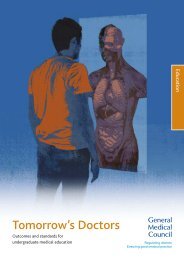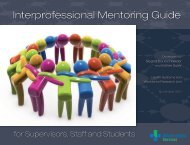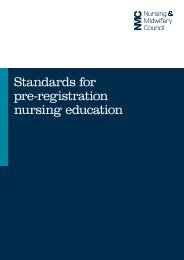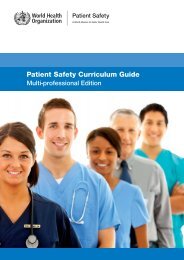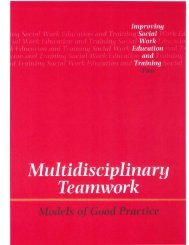6. Regulat<strong>in</strong>g <strong>and</strong> assur<strong>in</strong>g qualityPre-registration IPE was <strong>and</strong> cont<strong>in</strong>ues to be subject to separate regulation with<strong>in</strong>each of the professional courses <strong>in</strong> which it is embedded. Satisfy<strong>in</strong>g two or moresets of requirements is complex, time consum<strong>in</strong>g <strong>and</strong> sometimes frustrat<strong>in</strong>g.Attempts to resolve some of these problems date back to the 1980s (EnglishNational Board for Nurs<strong>in</strong>g, Midwifery <strong>and</strong> Health Visit<strong>in</strong>g & Central Council for<strong>Education</strong> <strong>and</strong> Tra<strong>in</strong><strong>in</strong>g <strong>in</strong> Social Work, 1992). The years under review saw thedevelopment of broader-based underst<strong>and</strong><strong>in</strong>g <strong>and</strong> collaboration between regulatorybodies.The Department of Health brought together <strong>in</strong>terested parties <strong>in</strong>clud<strong>in</strong>g the HealthProfessions Council (HPC) <strong>and</strong> the Nurs<strong>in</strong>g <strong>and</strong> Midwifery Council (NMC) todevelop the „Partnership Quality Assurance Framework‟ (PQAF) to carry forwardwork which it had started with the then English National Board. The exercisefocused on the role of Strategic Health Authorities <strong>in</strong> commission<strong>in</strong>g award-bear<strong>in</strong>gprogrammes of learn<strong>in</strong>g for nurs<strong>in</strong>g <strong>and</strong> midwifery <strong>and</strong> the allied <strong>health</strong> professions<strong>in</strong> Engl<strong>and</strong>, tak<strong>in</strong>g <strong>in</strong>to account the role of the QAA <strong>and</strong> its benchmark<strong>in</strong>gstatements (see below).The PQAF fed <strong>in</strong>to a review of non-medical regulation (Department of Health,2006a), which focused on ensur<strong>in</strong>g proper protection for the public. Regulatorsshould, said m<strong>in</strong>isters, be more consistent with each other about the st<strong>and</strong>ards theyrequired for persons enter<strong>in</strong>g their registers for the first time. Revalidation wasnecessary for all professions, based on the Knowledge <strong>and</strong> Skills Framework 10 ,which implied a degree of st<strong>and</strong>ardisation across professions. There weresubstantial areas <strong>in</strong> which common st<strong>and</strong>ards were said to be desirable. Statutoryregulation would be extended to <strong>in</strong>clude new roles, such as that of medical <strong>care</strong>practitioner (physician assistant), but work rema<strong>in</strong>ed to be done to decide whetherthis should be the responsibility of a s<strong>in</strong>gle regulatory body or several with a “leadregulator”. These <strong>and</strong> other decisions <strong>in</strong>troduced a greater degree of control overthe regulatory bodies, but arguments for their amalgamation were set aside (savefor the two bodies responsible for pharmacy). Further harmonisation was, however,to be kept under review <strong>in</strong>clud<strong>in</strong>g the possibility of a further reduction <strong>in</strong> theirnumber. A parallel review by the Chief Medical Officer dealt with the regulation ofmedic<strong>in</strong>e (Department of Health, 2006b).The General Social Care Council, the HPC <strong>and</strong> the NMC broadly reaffirmed theirpredecessors‟ 11 commitment to IPE <strong>and</strong> collaborative practice <strong>in</strong> l<strong>in</strong>e with theGeneral Medical Council (GMC) 12 .10 The Knowledge <strong>and</strong> Skills Framework (Department of Health, 2004b; NHS Modernisation Agency,2004) was designed to support personal development <strong>in</strong> post, <strong>care</strong>er development <strong>and</strong> servicedevelopment, as well as to ensure transferability of roles, for all types <strong>and</strong> grades of NHS staff. Itssubsequent development rested with „Skills of Health‟ under whose auspices it provided a backdropfor discussions about the organisation <strong>and</strong> regulation of the <strong>health</strong> professions. Skills for Healthpublished national occupational st<strong>and</strong>ards (NOS) <strong>and</strong> national workforce competences (NWC) toprovide statements of competence <strong>and</strong> good practice <strong>and</strong> measure performance outcomes(www.skillsfor<strong>health</strong>.org.uk) to be taken <strong>in</strong>to account when design<strong>in</strong>g higher education programmes.11 The Central Council for <strong>Education</strong> <strong>and</strong> Tra<strong>in</strong><strong>in</strong>g <strong>in</strong> Social Work, the Council for ProfessionsSupplementary to Medic<strong>in</strong>e <strong>and</strong> the UK Central Council for Nurs<strong>in</strong>g, Midwifery <strong>and</strong> Health Visit<strong>in</strong>g<strong>and</strong> its four related National Boards.30
The allied <strong>health</strong> professionsSt<strong>and</strong>ards of proficiency for all professions regulated by the HPC required thatregistrants understood the need to build <strong>and</strong> susta<strong>in</strong> professional relationships bothas <strong>in</strong>dependent practitioners <strong>and</strong> collaboratively as members of teams, <strong>and</strong> wereable to contribute effectively to work undertaken as part of multidiscipl<strong>in</strong>ary teams(Department of Health, 2000b; HPC, 2005), but guidance for the conduct of visits toprogrammes <strong>in</strong>jected a note of caution. Profession specific skills <strong>and</strong> knowledge hadto be adequately addressed when <strong>in</strong>terprofessional learn<strong>in</strong>g was <strong>in</strong>cluded.Prompted by the belief that it might be difficult to offer <strong>in</strong>terprofessional learn<strong>in</strong>gbecause of factors beyond providers‟ control, the HPC did not require it, but did<strong>in</strong>clude it <strong>in</strong> its st<strong>and</strong>ards of proficiency, conduct, performance <strong>and</strong> ethics (HPC,2008).Nurs<strong>in</strong>g <strong>and</strong> midwiferyProficient practice, said the NMC, must reflect collaboration with other members ofthe <strong>care</strong> team. St<strong>and</strong>ards set for nurs<strong>in</strong>g were not separate <strong>and</strong> <strong>in</strong>sular professionalaspirations, but l<strong>in</strong>ked to the wider goals of achiev<strong>in</strong>g cl<strong>in</strong>ical effectiveness with<strong>in</strong><strong>health</strong> <strong>care</strong> teams <strong>and</strong> agencies. It was therefore necessary that nurs<strong>in</strong>g st<strong>and</strong>ardsof proficiency encompass the capacity to contribute to this wider <strong>health</strong> <strong>care</strong>agenda. Newly registered nurses should demonstrate an underst<strong>and</strong><strong>in</strong>g of the roleof others by participat<strong>in</strong>g <strong>in</strong> <strong>in</strong>terprofessional practice, establish<strong>in</strong>g <strong>and</strong> ma<strong>in</strong>ta<strong>in</strong><strong>in</strong>gcollaborative work<strong>in</strong>g relationships with members of the <strong>health</strong> <strong>and</strong> <strong>social</strong> <strong>care</strong> team.Furthermore, they should contribute to the learn<strong>in</strong>g of those others by shar<strong>in</strong>gknowledge <strong>and</strong> experience. Programmes had to ensure that students had theopportunity to learn with <strong>and</strong> from other <strong>health</strong> <strong>and</strong> <strong>care</strong> professions <strong>in</strong> practice <strong>and</strong><strong>in</strong> academic sett<strong>in</strong>gs where possible <strong>and</strong> f<strong>in</strong>d creative ways for <strong>in</strong>terprofessionallearn<strong>in</strong>g to take place throughout the programme so that students could develop theskills they need to work collaboratively with other <strong>health</strong> <strong>and</strong> <strong>social</strong> <strong>care</strong>professionals (NMC, 2002, 2004, 2008 & 2010).Social WorkPend<strong>in</strong>g publication by the GSCC of quality assur<strong>in</strong>g the <strong>social</strong> work degree, theDepartment of Health (2002b) issued requirements, underwritten <strong>in</strong> the NationalOccupational St<strong>and</strong>ards for Social Work (2002), for assess<strong>in</strong>g competence <strong>in</strong>practice. Providers had to demonstrate that all students undertook learn<strong>in</strong>g <strong>and</strong>assessment <strong>in</strong> partnership work<strong>in</strong>g <strong>and</strong> <strong>in</strong>formation shar<strong>in</strong>g across professions <strong>and</strong>agencies, were competent to work <strong>in</strong> multidiscipl<strong>in</strong>ary <strong>and</strong> multi–organisationalteams, networks <strong>and</strong> systems, to develop <strong>and</strong> ma<strong>in</strong>ta<strong>in</strong> effective work<strong>in</strong>grelationships, agree goals <strong>and</strong> objectives <strong>and</strong> deal constructively withdisagreements <strong>and</strong> conflicts. These requirements will be subject to review follow<strong>in</strong>gthe impend<strong>in</strong>g <strong>in</strong>corporation of <strong>social</strong> <strong>care</strong> <strong>in</strong>to the HPC.Medic<strong>in</strong>eThe GMC required its graduates to “know about, underst<strong>and</strong> <strong>and</strong> respect the roles<strong>and</strong> expertise of other <strong>health</strong> <strong>and</strong> <strong>social</strong> <strong>care</strong> professionals” <strong>and</strong> to be “able todemonstrate effective team work<strong>in</strong>g skills”. “Medical schools should explore <strong>and</strong>,12 See www.caipe.org for a comparative critique of requirements made for IPE by the HPC, the NMC,the GSCC <strong>and</strong> the GMC.31
- Page 4: ForewordsThis report is an importan
- Page 7: PrefaceThe turn of the Century was
- Page 13 and 14: 2. Promoting Interprofessional Educ
- Page 15: capabilities were published. The Sh
- Page 18: develop sustainable abilities appro
- Page 21 and 22: 4. Developing teaching and learning
- Page 23 and 24: Students were expected to achieve t
- Page 25 and 26: Assessing learningIt became clear o
- Page 27 and 28: Assessment and Learning in Practice
- Page 29 and 30: different professions at Coventry U
- Page 31: show how students created new inter
- Page 35 and 36: Information for prospective student
- Page 37 and 38: as well as quantitative - for the e
- Page 39 and 40: “Interprofessional learning/educa
- Page 41 and 42: CAIPE convened two-day „split‟
- Page 43 and 44: 9. Taking stockThe widespread suppo
- Page 45 and 46: References:Anderson, E.S, Cox, D. &
- Page 50 and 51: Interprofessional Education Collabo
- Page 52 and 53: Pearson, P., Ashcroft, D., and Buck
- Page 54 and 55: determinants of population health V
- Page 56 and 57: B. A bibliographyBooks and papers f
- Page 58: Wilcock, P., Campion-Smith, C. & El




